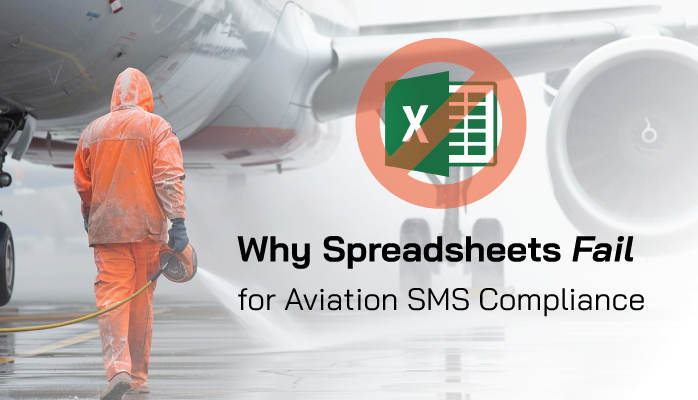Spreadsheets for Aviation SMS Compliance

For aviation safety managers and accountable executives, implementing an effective Safety Management System (SMS) is critical to meeting ICAO Annex 19, FAA Part 139, and EASA regulations. Many organizations, especially smaller operators, rely on manual processes like spreadsheets to manage safety data, hoping to save costs. However, spreadsheets are error-prone, inefficient, and inadequate for long-term SMS compliance.
This article explores why manual processes fall short, provides real-world examples, and highlights how dedicated SMS software like SMS Pro ensures compliance and enhances safety.
The Allure of Spreadsheets for Aviation SMS
Spreadsheets, such as Microsoft Excel or Google Sheets, seem like an attractive option for managing aviation SMS. They’re low-cost, familiar, and customizable. For small fixed-base operators (FBOs) or regional airports, spreadsheets can track basic incidents or hazards without upfront investment. But as regulatory demands grow and operations scale, the limitations of manual processes become glaring. Let’s dive into why spreadsheets are a risky choice for long-term SMS compliance.
Key Limitations of Spreadsheets for Aviation SMS
1. Error-Prone Data Entry Risks Safety
Manual data entry in spreadsheets is a recipe for errors. Typos, duplicate entries, or incorrect formulas can distort safety data, leading to flawed risk assessments.
Example: A small airline used Excel to log pilot fatigue reports. A data entry error misclassified a high-risk fatigue incident as low-risk, delaying corrective actions. This oversight led to a near-miss during a landing, highlighting how spreadsheet errors can jeopardize safety.
Impact: Inaccurate data undermines the proactive risk management required by ICAO’s SMS framework, exposing organizations to regulatory penalties and safety risks.
2. Lack of Real-Time Collaboration
Aviation operations are dynamic, with safety managers, pilots, and maintenance teams needing real-time access to safety data. Spreadsheets stored locally or shared via email create version control chaos, where updates are overwritten or lost.
Example: An airport’s safety team used a shared Excel file to track runway incursions. When two managers updated the file simultaneously, one set of entries was lost, delaying a critical safety committee review. This caused a temporary lapse in compliance with FAA Part 139 reporting requirements.
Impact: Without real-time collaboration, safety managers struggle to maintain accurate, up-to-date records, hindering timely decision-making.
3. Inadequate for Regulatory Compliance

ICAO Annex 19 mandates a structured SMS with components like safety performance indicators (SPIs), audit trails, and corrective action tracking. Spreadsheets lack these features, making it nearly impossible to demonstrate compliance during audits.
Example: During an EASA audit, a maintenance, repair, and overhaul (MRO) organization relied on spreadsheets for hazard reporting. The lack of automated audit trails and standardized templates led to a non-compliance finding, requiring costly remediation.
Impact: Manual processes fail to meet regulatory standards, risking fines, operational restrictions, or reputational damage.
4. Scalability Nightmares
Spreadsheets work for small teams but buckle under the weight of growing operations. Large datasets slow performance, and managing complex SMS requirements for airlines or airports becomes unfeasible.
Example: A regional airline with 50 employees initially used Excel for SMS. As it expanded to 200 employees, the spreadsheet became unwieldy, with slow load times and frequent crashes. Safety managers spent hours consolidating data, delaying critical safety reports.
Impact: Scalability limitations divert resources from safety management to data maintenance, stunting SMS maturity.
5. Security and Data Integrity Vulnerabilities
Safety data is sensitive, requiring robust access controls and backups. Spreadsheets lack these, increasing the risk of unauthorized access or data loss.
Example: A small FBO stored SMS data in a shared Excel file on a local server. A cyberattack corrupted the file, erasing months of incident records. Without backups, the FBO faced delays in reconstructing data for an FAA audit.
Impact: Data breaches or losses compromise compliance and erode trust in the SMS.
6. Time-Intensive and Inefficient
Maintaining spreadsheets is labor-intensive, with safety managers spending hours on data entry, formatting, and validation instead of focusing on risk mitigation.
Example: An airport safety manager spent 10 hours weekly updating an Excel-based risk register, leaving little time for proactive hazard analysis. This reactive approach missed early signs of a recurring taxiway congestion issue.
Impact: Inefficiency hampers proactive safety management, a core pillar of ICAO’s SMS framework.
7. Limited Analytical Capabilities
Proactive SMS requires advanced analytics, such as trend analysis or predictive risk modeling. Spreadsheets offer basic charts but lack real-time dashboards or KPIs.
Example: A charter operator used Excel to track safety incidents but couldn’t generate real-time SPIs for executive oversight. This delayed identifying a pattern of maintenance delays, leading to a costly grounding of aircraft.
Impact: Without robust analytics, executives lack the insights needed for data-driven safety decisions.
Why Dedicated SMS Software Is the Solution
Dedicated aviation SMS software, like SMS Pro, addresses the shortcomings of spreadsheets by offering aviation-specific tools, automation, and compliance-ready features. Here’s how SMS Pro transforms SMS for safety managers and accountable executives:
- Error-Free Data Management: Customizable forms and automated validation reduce errors in hazard reporting and incident logging.
- Real-Time Collaboration: Cloud-based access ensures teams across locations stay aligned, with version control and audit trails.
- Regulatory Compliance: Built-in templates for ICAO Annex 19, FAA Part 139, and EASA, plus automated SPIs and audit support.
- Scalability: Supports organizations from 1 to 500+ employees, with flat pricing ($300/month for 30 users) for cost-effectiveness.
- Security: Role-based access, encrypted data, and automatic backups protect sensitive safety information.
- Efficiency: Automated workflows and notifications free safety managers to focus on risk mitigation.
- Advanced Analytics: Real-time dashboards and KPIs empower executives with actionable insights.
Case Study: A mid-sized MRO transitioned from Excel to SMS Pro. Within six months, audit preparation time dropped by 70%, error rates fell by 90%, and the organization achieved full ICAO compliance, earning praise during an EASA audit.
Transitioning from Spreadsheets to SMS Pro
Switching to dedicated SMS software doesn’t have to be daunting. Here’s a quick guide for safety managers:
- Assess Needs: Identify your SMS gaps (e.g., compliance, scalability, analytics).
- Evaluate Software: Choose aviation-specific solutions like SMS Pro, with features tailored for airlines, MROs, or airports.
- Migrate Data: Import existing spreadsheet data into SMS Pro’s secure platform with support from their team.
- Train Staff: Leverage SMS Pro’s embedded training videos to onboard teams quickly.
- Monitor Progress: Use dashboards to track SPIs and ensure compliance.
Conclusion: Don’t Risk Safety With Spreadsheets
Spreadsheets may seem like a quick fix for aviation SMS, but their error-prone nature, compliance gaps, and scalability issues make them a liability for long-term safety management. For aviation safety managers and accountable executives, investing in dedicated SMS software like SMS Pro is the smart choice. With its aviation-specific features, cost-effective pricing, and compliance-ready tools, SMS Pro empowers organizations to achieve ICAO, FAA, and EASA compliance while enhancing safety.
Ready to upgrade your SMS? Visit www.asms-pro.com to explore SMS Pro’s features and request a demo. Take control of your safety management today!





